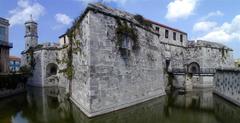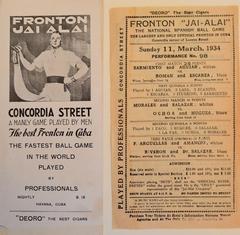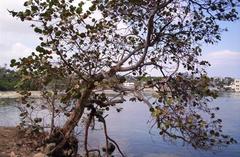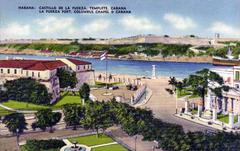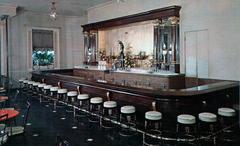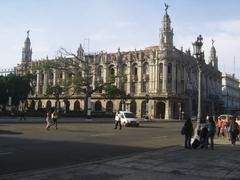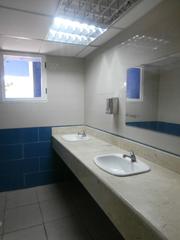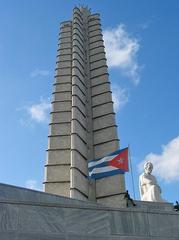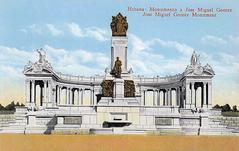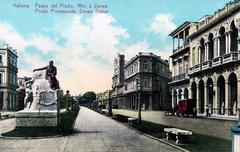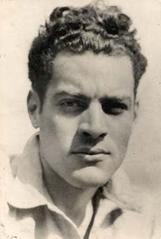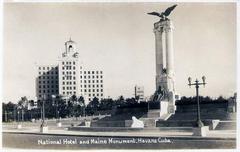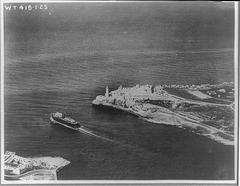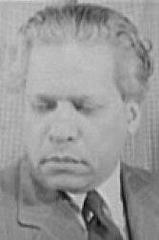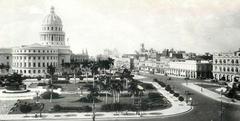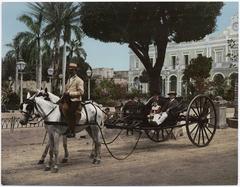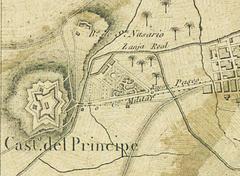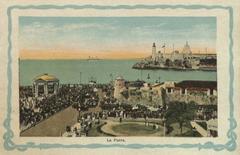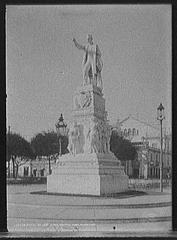
Plaza de la Catedral, Havana: Visiting Hours, Tickets, and Historical Sites Guide
Date: 04/07/2025
Introduction: History and Cultural Significance
Plaza de la Catedral stands as one of the most emblematic squares in Old Havana, Cuba, offering a captivating glimpse into the island’s colonial heritage and contemporary culture. Originally a swampy area called Plaza de la Ciénaga, it was transformed in the 18th century into a prestigious religious and civic hub centered around the magnificent Catedral de San Cristóbal de la Habana. This cathedral, a masterpiece of Cuban Baroque architecture built from coral stone embedded with marine fossils, features distinctive asymmetrical bell towers and a restrained Tuscan façade. The square is further enriched by elegant colonial mansions and museums such as the Museo del Arte Colonial and the Palacio del Conde Lombillo, displaying preserved baroque and neoclassical details.
Beyond its architectural grandeur, Plaza de la Catedral is deeply woven into Havana’s social and religious fabric. It has hosted major ceremonies, public celebrations, and cultural events for centuries. Its historical importance is amplified by connections to figures such as Christopher Columbus, whose remains rested in the cathedral for over a century. Designated a UNESCO World Heritage Site in 1982, the plaza continues to be meticulously preserved, offering an immersive experience of Cuba’s layered past and vibrant present. Visitors can explore the plaza and cathedral during accessible hours, often enhanced by guided tours and the lively atmosphere of evening performances and festivals (rustytraveltrunk.com, wikipedia, tripcuba.org, whc.unesco.org).
Table of Contents
- Introduction
- Origins and Early Development
- Architectural Evolution
- Cultural and Religious Significance
- Notable Events and Historical Moments
- Preservation and UNESCO World Heritage Status
- Architectural Highlights and Visitor Experience
- Visitor Information: Hours, Tickets, and Tips
- Frequently Asked Questions (FAQ)
- Conclusion
- Call to Action
Origins and Early Development
Plaza de la Catedral is one of Old Havana’s five principal squares, occupying a site with a rich and layered history. Initially a natural swamp prone to flooding and known as “Plaza de la Ciénaga,” the area was eventually drained and repurposed as a naval dockyard, underscoring Havana’s maritime significance during Spanish rule (rustytraveltrunk.com, wikipedia). By the 18th century, as Havana’s port grew in prominence, the site was selected for a new cathedral and grand mansions, marking its transformation into a civic and religious center (whc.unesco.org).
Architectural Evolution
The plaza’s architectural character is defined by its harmonious blend of Baroque and neoclassical styles, a testament to Havana’s colonial legacy (audiala.com). The Catedral de San Cristóbal de la Habana, whose construction began in 1748 under the Jesuits, stands as the square’s most iconic structure. Although the Jesuits were expelled in 1767, construction was completed and the cathedral was consecrated in 1788.
The cathedral exemplifies Cuban Baroque style with its asymmetrical twin bell towers and coral stone façade. The interior is relatively austere, featuring marble floors, massive stone pillars, and eight side chapels arranged around a nearly square floor plan (tripcuba.org, rustytraveltrunk.com).
Surrounding the cathedral are significant colonial mansions, including the Palacio del Conde Lombillo and Museo del Arte Colonial, notable for arcades, wrought-iron balconies, and internal courtyards typical of 18th- and 19th-century Havana (wikipedia, whc.unesco.org).
Cultural and Religious Significance
Plaza de la Catedral has long been a focal point for Havana’s religious, social, and cultural life. The cathedral, initially dedicated to the Virgin of the Immaculate Conception, became the seat of the Catholic Archdiocese of Havana (tripcuba.org). For over a century, Christopher Columbus’s remains were kept in the cathedral until their transfer to Seville in 1898 (rustytraveltrunk.com).
The plaza’s transformation from a swamp to a civic hub mirrors Havana’s evolution. It has hosted countless ceremonies, processions, and cultural events, reinforcing its role as a living stage for Cuban history (audiala.com).
Notable Events and Historical Moments
Over the centuries, the plaza has been the site of grand religious ceremonies and public celebrations, including the annual feast of San Cristóbal, Havana’s patron saint (tripcuba.org). In the 20th century, it became a symbol of Havana’s cultural renaissance, hosting open-air concerts, art exhibitions, and performances. The statue of flamenco dancer Antonio Gades at the Palacio del Conde Lombillo is a tribute to the square’s ongoing cultural vibrancy (wikipedia).
Preservation and UNESCO World Heritage Status
The plaza’s historical and architectural significance contributed to Old Havana’s UNESCO World Heritage Site designation in 1982 (whc.unesco.org). Restoration efforts, led by the Cuban state and the Office of the Historian of Havana, continue to preserve the square’s unique character (audiala.com). The cobblestone surface, historic facades, and shaded arcades offer visitors an immersive experience of Havana’s living history (nationalgeographic.com).
Architectural Highlights and Visitor Experience
The nearly square layout of the plaza is dominated by the cathedral and surrounded by stately mansions. The Museo del Arte Colonial, in a former aristocratic residence, provides insights into colonial life, while the Palacio del Conde Lombillo is renowned for its arcades and balconies. Climbing the cathedral’s bell tower offers panoramic views of Old Havana (rustytraveltrunk.com). The interplay of light on coral stone at sunset is especially photogenic.
Visitor Information: Hours, Tickets, and Tips
- Visiting Hours: The plaza is open 24/7. The Catedral de San Cristóbal is generally open from 9:00 AM to 5:00 PM, but hours may vary for religious holidays.
- Tickets: Access to the plaza is free. The cathedral may charge a small admission fee (approximately 3 CUC); guided tours can be booked onsite or through agencies.
- Accessibility: Cobblestone streets may be challenging for those with mobility impairments; ramps are available at cathedral entrances.
- Guided Tours: Numerous guided walking tours of Old Havana include the plaza, offering context and access to interior spaces.
- Nearby Attractions: Plaza Vieja, Museo del Ron Havana Club, and Calle Obispo are all within walking distance.
Practical Tips for Visitors
- Best Time to Visit: November to April (dry season) offers the best weather for walking tours and events (Travellers Worldwide).
- Dress Code: Comfortable shoes for cobblestones; modest attire for cathedral visits.
- Safety: Old Havana is generally safe, but remain vigilant for petty theft (Latin America Backpacking).
- Currency: Carry cash (CUP, USD, or Euros); credit card acceptance is limited.
- Wi-Fi: Limited in the plaza, but available in some nearby establishments.
Frequently Asked Questions (FAQ)
Q: What are the plaza and cathedral visiting hours?
A: The plaza is open 24/7; the cathedral typically from 9:00 AM to 5:00 PM.
Q: Is there an entrance fee?
A: The plaza is free; the cathedral may charge a small admission fee.
Q: Are guided tours available?
A: Yes, guided walking tours are widely offered.
Q: Is the plaza accessible for visitors with disabilities?
A: Cobblestones may pose challenges; ramps are available at the cathedral.
Q: What are the nearby attractions?
A: Plaza Vieja, Museo de la Ciudad, and Calle Obispo are all within walking distance.
Conclusion
Plaza de la Catedral is a must-visit for anyone exploring Havana’s rich heritage. Its blend of historical significance, architectural beauty, and lively cultural scene offers a memorable experience for travelers. Whether admiring the cathedral, enjoying local music, or exploring nearby museums, visitors leave with a deeper appreciation of Havana’s soul.
Plan your trip around the cathedral’s opening hours, consider guided tours, and explore the neighboring plazas and attractions for a truly immersive experience.
Call to Action
Ready to explore Plaza de la Catedral and other Havana landmarks? Download the Audiala app for curated travel guides, insider tips, and the latest updates on Cuba’s cultural sites. Explore related posts on Old Havana’s architecture and follow us on social media for daily inspiration and travel stories!
References
- Plaza de la Catedral in Havana: History, Architecture, and Visitor Guide, 2025, rustytraveltrunk.com (https://rustytraveltrunk.com/plaza-de-la-catedral/)
- Plaza de la Catedral, Wikipedia, 2025 (https://en.wikipedia.org/wiki/Plaza_de_la_Catedral)
- Plaza de la Catedral, UNESCO World Heritage Centre, 1982 (https://whc.unesco.org/en/list/204)
- Havana Cathedral, TripCuba, 2025 (https://www.tripcuba.org/havana-cathedral)
- Plaza de la Catedral, Audiala travel guide, 2025 (https://audiala.com/en/cuba/havana-province/old-havana)
- Old Havana World Heritage Site, National Geographic, 2025 (https://www.nationalgeographic.com/travel/article/old-havana-world-heritage-site)
- Plaza de la Catedral, InsightCuba (https://insightcuba.com/blog/2017/08/18/plaza-de-la-catedral)
- Plaza de la Catedral, Lonely Planet (https://www.lonelyplanet.com/cuba/havana/habana-vieja/attractions/plaza-de-la-catedral/a/poi-sig/1333804/1341260)
- Plaza de la Catedral, La Habana Guide (https://www.lahabana.com/guide/plaza-de-la-catedral/)
- Plaza de la Catedral, minube (https://www.minube.co.uk/place/cathedral-square—a111861)
- Best Time to Visit Cuba, Travellers Worldwide (https://travellersworldwide.com/best-time-to-visit-cuba/)
- Cuba in July, CubasBest (https://cubasbest.com/cuba-in-july/)
- Havana Safety, Latin America Backpacking (https://www.latinamericabackpacking.com/is-havana-safe/)
- Plaza de la Catedral, TripCuba (https://www.tripcuba.org/plaza-de-la-catedra-square-of-old-havana)
- Havana Travel Safety, TravelSafe Abroad (https://www.travelsafe-abroad.com/cuba/havana/)




